

Marijuana Cuts Tumor Growth by 50% Inside Prevention: How to reduce BPA levels by 60 percent in 3 days. We know BPA is all around us, and the CDC tells us the chemical is in almost 95 percent of us.

And we know that laboratory studies have linked BPA to breast cancer, along with a whole host of other serious health problems. But what is the leading source of the BPA that contaminates our bodies? If we removed that source, how much would our BPA levels drop? The Breast Cancer Fund and Silent Spring Institute conducted a study, published today in Environmental Health Perspectives, to find out. We enlisted five families for a week-long investigation. While the families were eating the fresh-food diet, their BPA levels dropped on average by 60 percent. Gregg Braden on Curing Cancer using our own Technology of Emotion. Toenails can reveal if you have cancer - Trends News. London: Scientists have claimed that our toenails can indicate if we are going to have lung cancer.

Clippings could be used to predict the risk years before the disease actually develops, they suggest. In a study conducted to measure nicotine levels in toenail samples from both smokers and non-smokers, the team of scientists at the University of San Diego in California, found those with the highest readings were over three times more likely to get cancer than those with the lowest, The Sun reports. Clippings could be used to predict the risk years before the disease actually develops. Over 10 percent with the highest levels had never smoked. The experts said their findings give an indication of the damaging effects of passive smoking. Toenails grow around one centimetre a year - far slower than fingernails - so provide better clues on long-term exposure to cigarette smoke. Serve broccoli with mustard to beat cancer. Adding radishes, rocket or wasabi, a form of Japanese horseradish, can have the same effect.
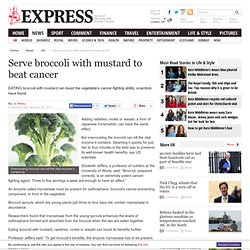
But overcooking the broccoli can kill the vital enzyme it contains. Steaming it quickly for just two to four minutes is the best way to preserve its well-known health benefits, say US scientists. X-ray device zaps deep cancers in 15 minutes. Catherine de Lange, reporter A super-accurate radiotherapy device that can target tumours deep inside the body is now bringing new hope to UK cancer patients.
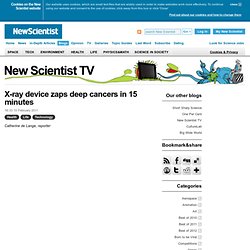
Radiosurgery is a non-invasive cancer treatment in which targeted radiation beams are used to destroy or shrink tumours. But the Novalis Tx device tailors these beams to match the exact shape, size and position of a tumour in the body. This means that a more intense beam can be used without causing damage to surrounding tissue. The device can also manoeuvre the beams to reach tumours deep inside the body, such as in the spinal cord, which were previously inaccessible. The system uses X-ray images of a tumour to monitor its position, and can even adapt when growths - such as those in the lungs - move as the patient breathes. Patients who would normally have to spend months recovering from complicated open surgery to remove brain tumours can now be treated in one session and return to normal life the following day.
Human Bacteria In The Production Of Human Cancer. Cancer Project / Cancer and Nutrition Web Seminars. The Key Ingredient to Effective Cancer Treatments. About 50 percent of cancer patients have tumors that are resistant to radiation because of low levels of oxygen—a state known as hypoxia.
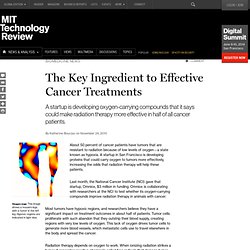
A startup in San Francisco is developing proteins that could carry oxygen to tumors more effectively, increasing the odds that radiation therapy will help these patients. Last month, the National Cancer Institute (NCI) gave that startup, Omniox, $3 million in funding. Omniox is collaborating with researchers at the NCI to test whether its oxygen-carrying compounds improve radiation therapy in animals with cancer. Most tumors have hypoxic regions, and researchers believe they have a significant impact on treatment outcomes in about half of patients. Coffee, Tea, Caffeine and Brain Cancer Risk. The information in this column is intended for informational purposes only, and does not constitute medical advice or recommendations by the author.

Please consult with your physician before making any lifestyle or medication changes, or if you have any other concerns regarding your health. Coffee and tea are widely enjoyed around the world, and both have been the subject of numerous health claims (most of them unproven). Tea, and green tea in particular, has been the focus of extensive research, with many prior studies suggesting that tea may improve cardiovascular health and, to a much lesser extent, may decrease the risk of some cancers. Cancer risk cut by fruit and veg diet. Smokers in particular can cut their risk but the variety they eat is just as important as the quantity.
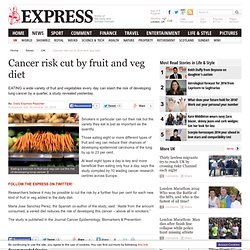
Those eating eight or more different types of fruit and veg can reduce their chances of developing epidermoid carcinoma of the lung by up to 23 per cent. At least eight types a day is key and more beneficial than eating only four a day, says the study compiled by 10 leading cancer research centres across Europe. FAQ - Why Do Alternative Cancer Therapies Forbid Meat? FAQ – Why Do Alternative Cancer Therapies Forbid Meat?

SpectroPen Lets Surgeons Find Tumors, Leave No Cancer Behind. Using IR light, dyes and gold nanoparticles, SpectroPen find tumors so surgeons can cut them out.
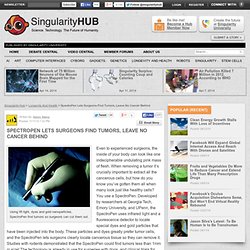
Even to experienced surgeons, the inside of your body can look like one indecipherable undulating pink mass of flesh. When removing a tumor it’s crucially important to extract all the cancerous cells, but how do you know you’ve gotten them all when many look just like healthy cells? You use a SpectroPen. Developed by researchers at Georgia Tech, Emory University, and UPenn, the SpectroPen uses infrared light and a fluorescence detector to locate special dyes and gold particles that have been injected into the body. These particles and dyes greatly prefer tumor cells, and the SpectroPen lets surgeons clearly locate cancerous tissue so they can remove it.
Study sheds light on aromatase inhibitor joint pain syndrome. Breast cancer patients are more likely to have joint pain from taking aromatase inhibitors (AIs) if they have advanced stage cancer, according to a study presented at the American College of Rheumatology's annual meeting, held Nov. 7-11, in Atlanta. The study is one of the first to identify factors that increase the likelihood that a patient will suffer joint pain from AI therapy.
No link found between iron and breast cancer. By Lynne Peeples NEW YORK Fri Nov 12, 2010 9:37pm GMT NEW YORK (Reuters Health) - While some prior research has hinted at a link between meat consumption and breast cancer, a large new study suggests that the iron in meat is probably not to blame.
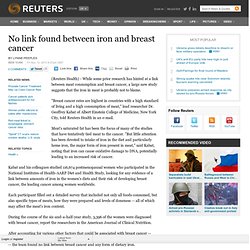
Colorectal cancer risk increases in prostate cancer patients on androgen deprivation therapy, study finds. Men taking androgen deprivation therapy (ADT) for prostate cancer may have an increased risk of colorectal cancer, according to a study published online November 10 in The Journal of the National Cancer Institute. Androgen deprivation therapy is a widely-prescribed treatment in men with prostate cancer, although its usage for low-risk disease remains controversial, given the adverse side effects, including osteoporosis, cardiovascular disease, diabetes and obesity; the last two are risk factors for colorectal cancer.
To determine whether prostate cancer patients taking androgen deprivation therapy are at an increased risk of colon cancer, Silke Gillessen, M.D., of the Cantonal Hospital in St. Dietary soy may affect risk of breast cancer - Sci/Tech. A new research has found that increased phytoestrogens, commonly found in dietary soy, may modify the risk of some types of breast cancer. The research has benn conducted by Anne Weaver, a graduate student at the University at Buffalo and research apprentice at Roswell Park Cancer Institute and colleagues. “This study was unique in that we looked at specific subtypes of breast cancer, and found a suggestion that menopausal status may play a role in risk,” said Weaver.
Weaver and colleagues evaluated 683 women with breast cancer and compared them with 611 healthy women. Those women with the highest isoflavone intake had an approximately 30% decreased risk of having an invasive breast tumor, and an approximately 60% decreased risk of having a grade 1 tumour. Lung Cancer & Hydrogen Peroxide (& the Genius of Dr. Hulda Clark) Nov. 4, 2010. Cancer vaccine allows body to kill tumours.